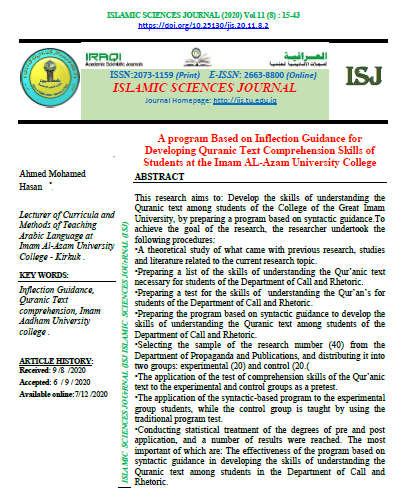A program Based on Inflection Guidance for Developing Quranic Text Comprehension Skills of Students at the Imam AL-Azam University College
Main Article Content
Abstract
ABSTRACT
This research aims to: Develop the skills of understanding the Quranic text among students of the College of the Great Imam University, by preparing a program based on syntactic guidance.To achieve the goal of the research, the researcher undertook the following procedures:
• A theoretical study of what came with previous research, studies and literature related to the current research topic.
• Preparing a list of the skills of understanding the Qur’anic text necessary for students of the Department of Call and Rhetoric.
• Preparing a test for the skills of understanding the Qur’an’s for students of the Department of Call and Rhetoric.
• Preparing the program based on syntactic guidance to develop the skills of understanding the Quranic text among students of the Department of Call and Rhetoric.
• Selecting the sample of the research number (40) from the Department of Propaganda and Publications, and distributing it into two groups: experimental (20) and control (20).
• The application of the test of comprehension skills of the Qur’anic text to the experimental and control groups as a pretest.
• The application of the syntactic-based program to the experimental group students, while the control group is taught by using the traditional program test.
• Conducting statistical treatment of the degrees of pre and post application, and a number of results were reached. The most important of which are: The effectiveness of the program based on syntactic guidance in developing the skills of understanding the Quranic text among students in the Department of Call and Rhetoric.
Article Details

This work is licensed under a Creative Commons Attribution 4.0 International License.
COLLEGE OF ISLAMIC SCIENCES, TIKRIT UNIVERSITY. THIS IS AN OPEN ACCESS ARTICLE UNDER THE CC BY LICENSE http://creativecommons.org/licenses/by/4.0/

